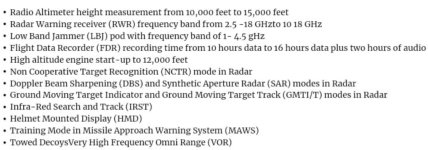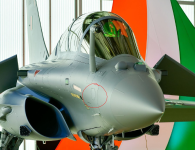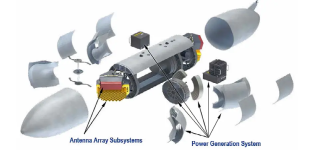No offesnse, Because US gears aren't available to everu one,even if they are willing to pay the price.We manage as best we can, it's not easy to fight against the Americans, the Rand Corporation doesn't understand why Dassault
Rafale DH/EH of Indian Air Force : News and Discussions
- Thread starter Herciv
- Start date
-
- Tags
- indian defence forum
You are using an out of date browser. It may not display this or other websites correctly.
You should upgrade or use an alternative browser.
You should upgrade or use an alternative browser.
It's okay. In all practical sense Rafale is still the most advance fighter flying today that is available for export. Don't think it's that behind the curve. With future variants like F4.2 and F5, Rafale's appeal is only going to increase. Putting all your eggs in the Stealth basket is going to be extremely foolish as even the mighty USAF is struggling. Having a combination of VLO, Advance 4th gens(like Rafale) and UCAV is the best bet for future air-combat, IMO.We manage as best we can, it's not easy to fight against the Americans, the Rand Corporation doesn't understand why Dassault is still present on the market, for them it's an anomaly.
Nor is French equipment.No offesnse, Because US gears aren't available to everu one,even if they are willing to pay the price.
I learned that the Indian standard with the ISE was superior to F4.1, in particular Spectra, and that certain specificities would remain solely Indian without being transferred to the French standards.
I also learned that the Rafale's AGCAS (Automatic Ground Collision Avoidance System) function saved the life of a French pilot, as well as an Indian pilot.
It's okay. In all practical sense Rafale is still the most advance fighter flying today that is available for export. Don't think it's that behind the curve. With future variants like F4.2 and F5, Rafale's appeal is only going to increase. Putting all your eggs in the Stealth basket is going to be extremely foolish as even the mighty USAF is struggling. Having a combination of VLO, Advance 4th gens(like Rafale) and UCAV is the best bet for future air-combat, IMO.

Pilot's mistake?I also learned that the Rafale's AGCAS (Automatic Ground Collision Avoidance System) function saved the life of a French pilot, as well as an Indian pilot.
The highest probability is that it's spatial disorientation in both cases, but I wasn't told.Pilot's mistake?
Time needs to be extremely precise, as precise as an atomic clock, not in absolute precision but in relative precision, basically the same time base. It is possible to have this precision with GPS or Galileo, but in the event of effective jamming we lose important functions, so as a back-up there is a time base in the link.
Isn't time in your control? In the case of passive TDOA localization, time isn't in your control, but in case of radar, you know the timestamp and the signal is in your own database. So, in principle, the receiver radars are acting as semi-active seekers. And all the transmitter has to do is transmit the signal name, PRN , PRF data, and timestamp to the receivers. Processed data can also be transmitted via SDR. And directional signals are possible with SDR too.
The idea is simple, if constant, uninterrupted connectivity is necessary for multistatic radar, then yeah, a patrol link is necessary. But if only a simple burst of information does the trick, then SDR in a secretive mode is more than enough. Everything is AESA now.
We manage as best we can, it's not easy to fight against the Americans,
I understand that and my point doesn't affect the stakeholders in the program. Like, I'm sure the IAF already knows about the F5 and even F6 timelines. Just pointing out that Dassault is very bad at managing public opinion. It also explains the negative view of the company amongst think tanks and even enthusiasts who have limited information.
the Rand Corporation doesn't understand why Dassault is still present on the market, for them it's an anomaly.
Big-bang vs evolutionary approach. No clue what the confusion is. The former requires more money and labour and is a hit or miss, so you have to spend more money if you miss.
I learned that the Indian standard with the ISE was superior to F4.1, in particular Spectra, and that certain specificities would remain solely Indian without being transferred to the French standards.
Possibly that low band jammer below the engine.
Low band jammers could be podded as per this:Possibly that low band jammer below the engine.

If Dassault integrated LBJ within the airframe then much kudos to them
 . Maybe @Picdelamirand-oil and @Bon Plan could testify?
. Maybe @Picdelamirand-oil and @Bon Plan could testify?Low band jammers could be podded as per this:
View attachment 29885
If Dassault integrated LBJ within the airframe then much kudos to them. Maybe @Picdelamirand-oil and @Bon Plan could testify?
Possible.
The Indian Rafale has this external modification.

Only the Indian one has this. So it indicates all other Rafales do not have this jammer covering the rear hemisphere.
The jammers on the wing roots and below the fin are X band, perhaps in the region of 6.5GHz to 11-12GHz. So I guess Ku band jamming against missile seekers comes out of the towed decoy. I'm not sure if there are any internal Ku band jammers present. The little jammer there could also be Ku band. Perhaps even K band.
It's unclear if other antennas, like the ones on the inlets, are just RWR/ESM or are capable of jamming. I doubt it for the versions below F3R.
Low band jammers could be podded as per this:
View attachment 29885
If Dassault integrated LBJ within the airframe then much kudos to them. Maybe @Picdelamirand-oil and @Bon Plan could testify?
Possible.
The Indian Rafale has this external modification.
View attachment 29889
Only the Indian one has this. So it indicates all other Rafales do not have this jammer covering the rear hemisphere.
The jammers on the wing roots and below the fin are X band, perhaps in the region of 6.5GHz to 11-12GHz. So I guess Ku band jamming against missile seekers comes out of the towed decoy. I'm not sure if there are any internal Ku band jammers present. The little jammer there could also be Ku band. Perhaps even K band.
It's unclear if other antennas, like the ones on the inlets, are just RWR/ESM or are capable of jamming. I doubt it for the versions below F3R.
In my opinion, that is too small to be a Low-band jammer.
I do however think it is indeed a jammer - but possibly operating in high/very high bands, designed to counter the Ka/Ku-band seekers of BVRAAMs.
So why isn't this mentioned in the list? Who knows...we know that this isn't the only thing that they omitted mentioning due to one reason or the other. There are access ports toward the nose on Indian Rafales than no other version has, and nobody knows what they are for.

Possibly an additional LRU that requires access for maintenance, but none of the mentioned ISEs require any additional LRUs in the radar back-end/electronics bay (can't be due to IRST as older French planes used to have IRST but these ports weren't there, plus the ports are on both sides)...so it's clear that a lot of stuff has been omitted from public disclosure for security reasons.
(Not to mention our Rafales are very likely nuclear-ready or at least intended to become nuclear-ready)
In my opinion, that is too small to be a Low-band jammer.
I do however think it is indeed a jammer - but possibly operating in high/very high bands, designed to counter the Ka/Ku-band seekers of BVRAAMs.
So why isn't this mentioned in the list? Who knows...we know that this isn't the only thing that they omitted mentioning due to one reason or the other. There are access ports toward the nose on Indian Rafales than no other version has, and nobody knows what they are for.
View attachment 29890
Possibly an additional LRU that requires access for maintenance, but none of the mentioned ISEs require any additional LRUs in the radar back-end/electronics bay (can't be due to IRST as older French planes used to have IRST but these ports weren't there, plus the ports are on both sides)...so it's clear that a lot of stuff has been omitted from public disclosure for security reasons.
(Not to mention our Rafales are very likely nuclear-ready or at least intended to become nuclear-ready)
For an L band antenna, you need a maximum of 30cm or just 0.3m or 1 feet. That size is enough for it. And it's still bigger than the nozzle petals. To make sense of the scale, the engine is 12 feet long.

The housing there is about the length of a forearm plus palm. So I'm more inclined to believe there's L and S band antennas in it. Of course, there's even space for Ku band. But it's too big for Ku band alone, which requires only an inch at max. That's less than what's connecting the nozzle petals and the engine frame.
The access panel is naturally more maintenance related than tech related. I'm guessing we need better access for a faster recaliberation of systems when the aircraft change geographies. This isn't as much of a problem for other operators operating from just one geographical location at a time, whereas the IAF has to run missions in deserts, forests, mountains and oceans in a matter of hours.
For an L band antenna, you need a maximum of 30cm or just 0.3m or 1 feet. That size is enough for it. And it's still bigger than the nozzle petals. To make sense of the scale, the engine is 12 feet long.

The housing there is about the length of a forearm plus palm. So I'm more inclined to believe there's L and S band antennas in it. Of course, there's even space for Ku band. But it's too big for Ku band alone, which requires only an inch at max. That's less than what's connecting the nozzle petals and the engine frame.
An LBJ that small can't probably transmit the kind of power needed to deal with long wavelength radars. You're gonna need more than that for effective jamming. Plus cooling that transmitter.
There's a reason LBJs are typically carried in pods.
What we have is essentially an addition/extension of the SPJ already present in the canard roots at the front. Basically, good enough to deal with the small seekers on AAMs and SAMs, but not much else.
And those seekers require jamming in the high/very high bands. So, I theorize it to be HBJ.
The access panel is naturally more maintenance related than tech related. I'm guessing we need better access for a faster recaliberation of systems when the aircraft change geographies. This isn't as much of a problem for other operators operating from just one geographical location at a time, whereas the IAF has to run missions in deserts, forests, mountains and oceans in a matter of hours.
Is there any indication of IAF planes having better turn-around times than the stock variants?
An LBJ that small can't probably transmit the kind of power needed to deal with long wavelength radars. You're gonna need more than that for effective jamming. Plus cooling that transmitter.
There's a reason LBJs are typically carried in pods.
What we have is essentially an addition/extension of the SPJ already present in the canard roots at the front. Basically, good enough to deal with the small seekers on AAMs and SAMs, but not much else.
And those seekers require jamming in the high/very high bands. So, I theorize it to be HBJ.
Pods carry their own power supply, hence the size. That's not necessary for this jammer, all delivered by the aircraft.
You can see here that the actual antenna itself is small. The pod size is mainly because of power supply. For the Rafale, only the orange bit is enough.

Is there any indication of IAF planes having better turn-around times than the stock variants?
Turnaround time is subject to the engine and airframe, nothing to do with those panels.
Pods carry their own power supply, hence the size. That's not necessary for this jammer, all delivered by the aircraft.
You can see here that the actual antenna itself is small. The pod size is mainly because of power supply. For the Rafale, only the orange bit is enough.
View attachment 29897
Yeah and there's a reason why they carry their own power supply. Which is what I said:
"An LBJ that small can't probably transmit the kind of power needed to deal with long wavelength radars. You're gonna need more than that for effective jamming."
Without a large dedicated RAT (which it's obvious that the small housing doesn't have) you cannot hope to overwhelm the kind of radars that use long-wavelengths (typically ground-based types powered by their own generator sets on trucks).
Which is why it makes no sense for it to be an LBJ. It would make sense for it to be a HBJ however. As the kind of sensors those jammers are meant to go up against typically require far less power to successfully jam, like AAM/SAM seekers.
Turnaround time is subject to the engine and airframe, nothing to do with those panels.
I doubt depot-level periodic maintenance needs would have necessitated inclusion of new hatches, especially if no new LRUs are present. You don't drill holes in the airframe (and all the structural testing & certification that would necessitate) to save a few minutes of time in an MRO job that takes weeks/months to complete anyway.
You only need extra access points either if you have new LRUs that cannot be reached/serviced from existing panels, or if the existing panel positions make post-flight checks and/or LRU hot-swapping difficult or time consuming.
Far before. in 2040 it will be F6 at least.Block obsolescence and stuff has moved to F5, finalised around 2040
2030 : F5, then F5.2, then F5.3.... as all the previous std.
2019....I'm starting to wonder who is more deceitful. You or the french? You can bet SEAD/DEAD has been shifted to F-5, What else hasn't been released.
F4 2023-2030
F5 2030-2040
View attachment 29860
since the NGF programme has been delayed (thanks to the germans) and a war occured in Europe. All, including Rafale std, has been re evaluated.




